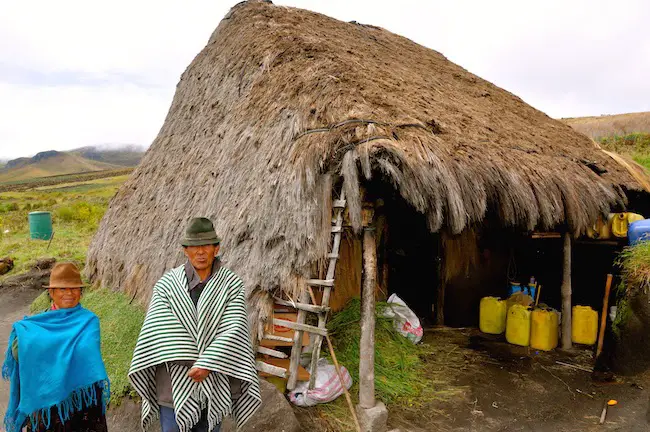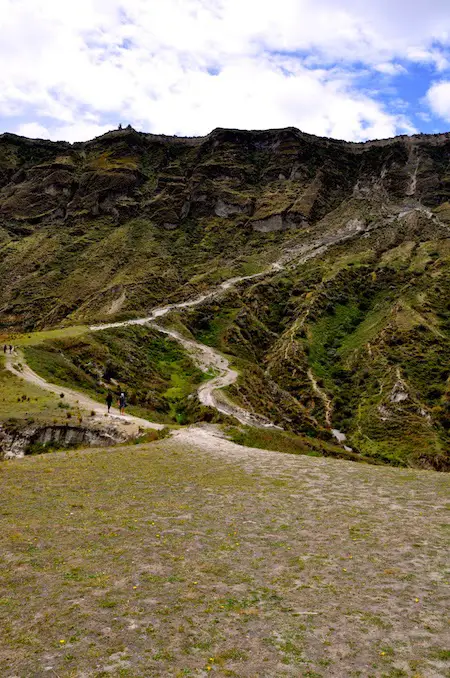My adventures in and around Quito, Ecuador continued today, with a very active hike that left me breathless for more than one reason, and a visit to a traditional Quechua homestead. It was a great mix of cultural immersion and outdoor adventure, something I’m finding this country excels at.
The day started with me having to check out of the very charming PapaGayo Hosteria, which was simply a wonderful place to spend the evening last night. The staff are incredibly warm, inviting, and hospitable, and I can’t recommend a stay there enough. If you’re thinking of coming to Ecuador, you should do yourself a favor and book a room there. The atmosphere is wonderful, the food is delicious, and rooms are very comfortable. PapaGayo is located not far from Cotopaxi National Park as well, and is a wonderful base camp for any number of adventures within the area.
After checkout, my guide and I were off to Saquisili, a nearby town that is famous for its open air market. Apparently, on Sundays and Thursdays, it is an incredible place to stop by and soak up the local atmosphere, while shopping for fresh fruits and vegetables, local craft goods, and innumerable local delicacies that are made fresh right on the spot. Unfortunately, on a Monday morning, the market was a bit subdued, with fewer shops open. Still, it was very nice to walk the aisles, taking in the sights, sounds, and especially the smells. The aroma of fresh fruit fills the air wonderfully, and numerous stands were selling bananas, oranges, strawberries, and enormous blackberries. Other shops were hawking shoes, bags, clothing, and DVD’s that didn’t look to be altogether legitimate, but they all fit into the atmosphere perfectly. I can only imagine what this experience would be like on a Sunday, when the entire town turns out to shop, swap gossip, and share a meal.
Since the market wasn’t as hopping as we had hoped, my guide suggested that we drop by the home of a local Quechua family with the extra time that we had on our hands. The Quechua tribes are indigenous to South America, and can trace their roots back thousands of years. Many of them still practice their traditional lifestyle, which includes living in a simple hut made of mud, stone, and leaves, while also farming the land, and raising some livestock. I’m always fascinated by new cultures, particularly ones as storied as the Quechua, so I was more than happy to take the opportunity to visit one of their homes.
This particular Quechua household belongs to the highland tribes of the Andes, although their are Quechua that live in the rainforest as well. The entire family lives in one small hut, including the grandparents, their five children and spouses, and 12 grandchildren. The kids were off to school as you would expect, while the other family members were working the field. That left the patriarch and matriarch of the clan at home to chat with us. It didn’t take long to figure out that they were just as hospitable and friendly as every other Ecuadorian that I’ve met on this trip. They offered us a snack of cooked potatoes and hot sauce, and patiently answered my questions about their lifestyle. They also told jokes, laughed heartily, and eager to share their home with visitors.
That home is about as simple as you could possibly imagine. It has a raised bed where the children sleep, while the adults curl up in blankets on the floor. They cook their meals on small traditional stoves and in the fire place, which also provides heat on the cold, rainy nights in the Andes. A small cage kept contained a quail, which provides the family with eggs, while more than 80 guinea pigs scurried about the room. The guinea pigs are part of their regular meals, and throughout my visit, the little guys cooed soothingly. To say they were adorable would be an understatement, but for the Quechua these animals are not pets, but an important source of food that they have included in their diets for hundreds of years.
After saying our goodbyes, we were back on the road to our ultimate destination of the day – Quilotoa Lagoon. This lake was formed more than 800 years ago, when the Quilotoa volcano erupted, causing the caldera to collapse. Now, the crater is more than 3 km (2 miles) across, and is a popular destination for visitors looking for a challenging hike in a beautiful setting.
The views from the top of the crater rim, which sits at 4000 meters (13,123 ft) are nothing short of spectacular. The lake is beautifully contained inside the walls of the volcano, which remains active to this day. In fact, when you stand on the edge of the water, you can occasionally see the tell-tale signs of bubbles, created by seismic activity underneath, rising to the surface. While there are no signs that Quilotoa has any plans to erupt anytime soon, it is humbling to know that it could.
Taking in the entire scene from the top is wonderful of course, but most visitors will want to walk down to the edge of the lake itself. Fortunately, there is an extremely well maintained trail that can facilitate that desire. The trail meanders down the side of the walls of the caldera, dropping some 200 meters (656 ft) in the process. As you can probably imagine, going down is fairly easy, but going up can be tough.
My guide indicated that a typical hike down the trail takes about a half hour to complete, while the return trip is closer to 45 minutes, depending on your level of physical fitness, and how well acclimatized you are to the altitude. We made the descent in just 20 minutes, with stops for pictures along the way, and then climbed back out in just over 30 minutes. It was a tough slog, and I was happy to see my guide breathing almost as heavily as I was. When we got to the top, he informed me that he had just set a personal best time for the ascent, which was encouraging since I was able to mostly keep up with him the whole way, but led me to question his estimate of a 45-minute climb back out for the average visitor. Make no mistake, the ascent out of the crater is a demanding one, and most people will be better served with taking their time, stopping for a rest, and enjoying the scenery. The thin air can be felt on the steep sections of the trail, and any significant shift in altitude should be respected.
All of that said, hiking in and out of Quilotoa is a must-do for anyone visiting the Quito area. It is a spectacular landscape that can’t be full appreciated until you actually descend into the crater. It gives you the full scope of the size of the place, and provides some beautiful places to take photos as well. There is even a small hostel at the bottom of the crater, where visitors can book a night stay in advance, or inquire about rooms if they don’t want to face the daunting task of climbing out on the same day. The hostel also rents kayaks for those who want to paddle in this amazing setting as well.
Not long after we made the hike out, it was time to grab some lunch before starting the long drive back to Quito. Just as we were settling in, clouds descended on Quilotoa, bringing cold winds and rain with them. Needless to say, we were relieved to be out of the crater at that point, and enjoying warm, delicious potato soup instead. I felt a bit bad for the numerous people we had seen descending when we were on our way up. They were caught in a rainstorm, and facing the long climb in very uncomfortable conditions. Word to the wide my friends. If you visit Ecuador during the rainy seasons (October – December), carry your rain jacket with you everywhere.
After lunch, we were back on the road to Quito, although progress was slow thanks to the poor weather. The three-hour trip stretched to four and half, but eventually we made it back in once piece. Tonight, I’m staying in the fantastic Patio Andaluz in the heart of Quito’s Old Town. The atmosphere at this hotel is fantastic, and they provide a level of service that simply isn’t found at most establishments these days. This is old-school luxury right off Quito’s Independence Square, and just minutes from some of the city’s best historical attractions. It is definitely a real treat to get to stay in such a wonderful place.
Tomorrow, I’m off to start three days of trekking on three different trails. I’ll be traveling with Tropic, an adventure travel company that is leading the way in lodge-to-lodge trekking excursions in Ecuador. The first of those hikes will be a climb up Pasochoa Peak, a 4199 meter (13,776 ft) peak that is often used an acclimatization route for Cotopaxi. We’ll see how well my legs have recovered from todays workout. Hopefully it will all go well!
- Gear Review: The Xero Scrambler Mid is an Ultralight Hiking Shoe for Spring - March 1, 2023
- Gear Review: Yeti Roadie 48 Wheeled Cooler - August 18, 2022
- Kristin Harila Continues Pursuit of 8000-Meter Speed Record - August 16, 2022



